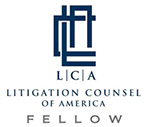The scenario is this: Your client is one of several members in a Multi-Member Indiana Limited Liability Company. Although business is good, your client learns that one of his co-members has creditors with a judgment against him and the judgment creditor now looks to the debtor-member’s LLC interest for collection. This article is designed to briefly examine the rights of the respective parties.
The Corporate Veil
As we all know, one of the largest benefits of incorporation (in this case an LLC) is the personal asset protection provided to its members. Regardless of corporate form, this protection is widely known as the “corporate veil.” However, this corporate veil protection is not absolute. Indiana law is well established that a creditor can “pierce the corporate veil” if it can prove that, among other things, the corporation was used to promote fraud, injustice, or illegal activities and/or the corporation was merely a “shell” to avoid personal liability.
While certainly not the situation all the time, I would submit that these aspects are less likely to be found in an MMLLC than in a Single Member LLC. In the latter, there is no one to look over an owner-member’s shoulder should he improperly commingle funds, pay for personal purchases through the business, attempt to hide assets, or otherwise fail to comply with corporate formalities. Irrespective of these possible differences, a piercing count and its concomitant analysis apply where a creditor has a judgment against the LLC itself. There is a different analysis as well as statutory and case law where an individual or entity is the personal creditor of a member of an LLC.
Outsider-Reverse Veil Piercing
Even where compliance with corporate formalities is met, members of an LLC may still face threats from the creditors of its individual members. An attempt to thwart the LLC’s touted protections and collect on a creditor’s personal judgment is known by various names including “outsider-reverse veil piercing.” Under the concept of ORVP, a personal creditor of a member may disregard the corporation’s separate legal existence and attempt to reach the debtor-member’s rights in the LLC. As will be discussed immediately below, this can be accomplished – depending upon particular state law – in various ways.
I.C. 23-18-6-7 and Charging Orders
The statute under analysis herein is I.C. 23-18-6-7. That statute sets out the rights of judgment creditors vis-a-vis members of an LLC. Under I.C. 23-18-6-7, a creditor may petition a court to allow it to charge a member’s interest in the LLC for the payment of the unsatisfied amount of the judgment. The relevant section reads: “[o]n application to a court with jurisdiction by a judgment creditor of a member, the court may charge the interest of the member in the limited liability company with the payment of the unsatisfied amount of the judgment with interest.” I.C. 23-18-6-7(a). This is known as a request for a charging order.
In its simplest form, a charging order is tantamount to a garnishment order except that, given the discretionary nature of distributions, payments are not so surely guaranteed. It is the vehicle by which a lien is placed upon a member’s economic interests in an LLC. Stated differently, the judgment-creditor obtains a charging order against the debtor-member which, in turn, places a lien upon the economic interest in the LLC to collect the judgment.
An economic interest is generally described as the right to share in the income, gains and losses of the LLC as well as to receive distributions. On the other hand, a noneconomic interest of a member generally means a member’s right to vote, manage and otherwise direct the operations of the LLC. Generally, the lien of a charging order does not intrude upon the noneconomic interests of the member. The question, ultimately, is whether a charging order is the exclusive remedy for a creditor regarding an LLC. That is, under current Indiana law can a creditor seek to obtain greater leverage by levying upon the noneconomic nature of a member’s interest? The answer as Indiana law currently stands is: it depends. And what this determination usually depends upon is whether one is dealing with an MMLLC or an SMLLC.
This determination is, obviously, of extreme importance to other members of an MMLLC in that, if a charging order is not the exclusive remedy, other remedies available to a creditor of a member can wreak utter havoc upon the viability of the LLC. That is, if a charging order is not the exclusive remedy, other options available to a judgment-creditor include (1) the right to foreclose upon a debtor-member’s interest as well as (2) an order of dissolution.
Foreclosure on a Member’s LLC Interest
In short, with an order of foreclosure, a judgment-creditor can foreclose on the debtor-member’s interests of the LLC, taking the interest in full or partial satisfaction of the debt. This, of course, turns a charging order into a much more powerful remedy. The creditor would not be limited to waiting for distributions that the LLC may never make. In foreclosure, the creditor could seize a member’s interests and possibly take control of a portion of ownership and/or management. This control could cause, for example, a forced distribution to the creditor in full or partial satisfaction of the debt. What is worse is the judgment-creditor gets the money while the member is left to pay the taxes on the distribution. Foreclosure could also result in the creditor selling the member’s interest in a public or private sale. One can easily see the turmoil this would cause in the LLC, especially with regard to its ownership and management.
Order of Dissolution
A third option for a judgment creditor is an order of dissolution. This would allow the creditor to force the LLC itself to be dissolved and its assets sold and/or otherwise applied to the satisfaction of the creditor’s judgment. This is the most draconian of remedies, resulting in an extreme hardship upon other members in an MMLLC who have absolutely no personal obligation for the debt. In the event of dissolution, the business would most likely be terminated and everyone tossed out, left to pick up the pieces the best that they can. Clearly, limiting creditors to a charging order is of extreme importance to members in an MMLLC.
What I.C. 23-18-6-7 Does Not Say and Interpretive Case Law
While I.C. 23-18-6-7 states that a judgment creditor may obtain a charging order, it does not state that a charging order is the exclusive remedy. The seminal case on this topic is Brant v. Krilich, 835 N.E.2d 582 (Ind. App. 2005). In Brant, the Court of Appeals definitively stated that a charging order is the exclusive remedy. However, the Brant decision does not provide all the answers, and there are several issues to still consider. As such, Brant should be applied with caution and after a thorough analysis.
One glaring issue is that, despite the ruling in Brant, I.C. 23-18-6-7 itself simply does not state that a charging order is the exclusive remedy. Moreover, while the Brant decision does so state, the facts under Brant dealt with an MMLLC. This disparity leaves open the question as to whether a charging order is truly the exclusive remedy as far as the Legislature is concerned and, in addition, whether it is the exclusive remedy with regard to SMLLCs.
House Bill 1394
Earlier this year in the 2013 legislative session, House Bill 1394 was introduced seeking to amend I.C. 23-18-6-7 to expressly provide that a charging order be the exclusive remedy. The bill sought to add language that “[a] creditor of a member or creditor of a member’s assignee does not have a right to obtain possession of, or otherwise exercise legal or equitable remedies with respect to, the property of the limited liability company.” Proposed (13) IN 1394.1.11(d). The proposed bill sought to further limit creditor’s rights by stating that a charging order under I.C. 23-18-6-7 would provide “the exclusive remedy by which a judgment creditor of a member may satisfy a judgment from a judgment debtor’s member interest in a limited liability company. A judgment creditor has no right to foreclose upon the charging order or the judgment debtor’s member interest.” Proposed (13) IN 1394.1.11(e).
This change would have leveled the playing field between SMLLCs and MMLLCs, expressly adopted the Brant decision, and extended Brant’s reach to SMLLCs. However, under pressure from the creditor’s bar, the Legislature failed to adopt the proposed amendment and the statute remains unchanged. Thus, at the end of the day, it appears that Brant provides members in an MMLLC with some protection … for now. However, the courts are always free to revisit or distinguish Brant and reliance upon it in the formation of an MMLLC would seem somewhat speculative. Brant notwithstanding, it is open for interpretation as to what rights a creditor has against a member of an SMLLC. I would suggest that, under the totality of the circumstances, and the practicalities of the differences between an SMLLC and an MMLLC, SMLLCs are not going to be limited to a charging order and Brant has little, if any, applicability toward SMLLCs.
The Practicalities and Document Drafting
Given the gravity of the issue and the risk of a change in the law, the question is really what can an MMLLC do to more fully protect its members. As mentioned, in an SMLLC, perhaps nothing. The reasoning is that with regard to an SMLLC, there are no “innocent” members to protect. That notwithstanding, an operating agreement similar to that used for an MMLLC wherein creditor’s rights are delineated and limited, may carry the day to protect a member in an SMLLC. The practical effects of such drafting in an SMLLC remain to be seen. Another possibility – and one that makes Indiana a less desirable place to incorporate – is to form the LLC under the laws of a state that does recognize a charging order as the exclusive remedy.
However, with regard to MMLLCs, a well-drafted operating agreement clearly is of crucial importance. The operating agreement of an MMLLC can and should address this reality, despite the Brant decision. The operating agreement should delineate exactly what happens to a member’s interests in the MMLLC if a creditor seeks the remedy of a charging order or, worse, a remedy beyond a charging order. It should also address the situation where a member is forced to file for bankruptcy protection.
The means to accomplish this end are innumerable. There can be forced disassociation of the member, first rights of refusal to the other members to purchase the member’s interest, and so forth. In the end, the operating agreement must set forth a clear understanding between the parties upon formation of the LLC and close the gap between the current Indiana statute, the Brant decision, and the risk of a change in the law either by the Legislature or the courts. Furthermore, litigators need to be aware of the rights and remedies of both creditors and members when these situations arise and the arguments and tactics to best assert our client’s position, regardless of which side of the “v” we represent.














